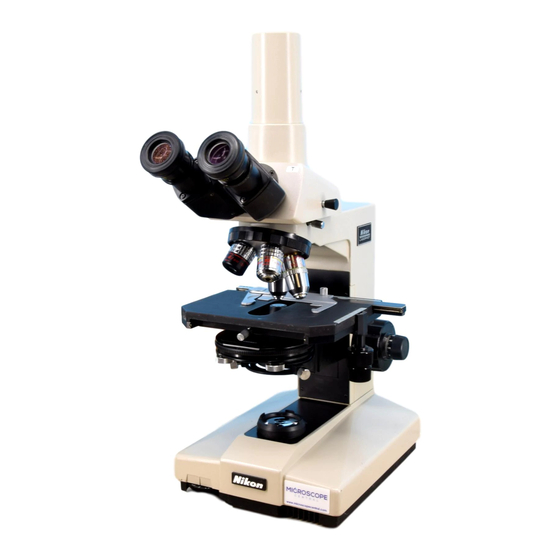Nikon Labophot Руководство по эксплуатации - Страница 12
Просмотреть онлайн или скачать pdf Руководство по эксплуатации для Микроскоп Nikon Labophot. Nikon Labophot 28 страниц. Y-r stand biological microscope

IV.
OPTICAL SYSTEM
The CF objectives and CF eyepieces adopted in
the Nikon Biological Microscope LABOPHOT
are designed on the basis of a new Nikon-
developed
concept
"Chromatic
Aberration
Free"
With the Nikon CF optical system the
chromatic
difference
of magnification
in the
objective and eyepiece is individually corrected.
This is unlike conventional microscopes where
the corrections of such aberration has been, for
the most part, compensated for in the objectives
and eyepiece as a pair. As a result the Nikon
Microscope LABOPHOT has no orange colored
fringe in the eyepiece. In cooperation with the
other optimum
aberration corrections such as
the
Nikon
Integrated
Coating,
a uniformly
sharp
image, much
superior
in resolution,
contrast and color rend ition is achieved over
100% of the effective, even, super-wide field of
view, for observation as well as color photo-
micrography.
.1. Objectives
Mechanical tube length of 160mm and parfocal
distance of 45mm (This is longer than the
33.6mm of earlier microscopes).
In every case
use the CF objectives in combination with the
CF eyepieces.
1) Types of objective
(1)
Achromat (CF)
In this type of objective, the correction of
chromatic aberrations is based on the lines
C (red) and F (blue). Importance being
given to the correction
at the center of
viewfield,
the objectives offer the finest
definition
and highest contrast of image
at the center. Even the 40X and
lOOX
objectives fulfill
the "Chromatic
Aberra-
tion
Free"
correction,
wh ich has been
considered difficult
so far until now for
such high magnifying powers. Furthermore,
image flatness has been attained
to an
appreciable extent.
(2) Plan Achromat (CF Plan)
Same as the above type, the objectives ac-
complish
the
correction
of
chromatic
aberrations based on the lines C and F.
In addition, owing to sufficient correction
of all the image defects up to the periphery
12
of viewfield,
the objectives
provide
an
unsurpassable high resolution and contrast
of image over a wider field.
Focusing at the center means simu Itaneous
focusing at the marginal part of viewfield.
They are excellent for ultra-wide observa-
tion and photomicrography.
(3) Plan Apochromat (CF Plan Apo)
The use of fluorite
and special, low color
dispersion
optical
glasses improves
the
correction
of chromatic
aberrations over
the ent ire visible region up to the line g
(violet) along with the lines C and F.
These highest-grade objectives wi th their
large numerical apertures produce an ideal
image over a wide viewfield.
With their
outstanding
definition,
superior color re-
producibility,
and prominent
image flat-
ness, they are especially suited for most
profound
study of minute structures and
color photomicrography .
(4) Epi-fluorescence (CF UV-F)
Exclusively
designed for episcopic, fluo-
rescence observat ion, th is type objectives
use non-fluorescent
and non-solarisation
materials and a strictly
chosen cementing
agent, to increase the transmission of UV
exciti ng light
(u Itra-vi olet
rays). Special
weight being attached to the correction at
the center of viewfield, and the numerical
apertures
made
extremely
large, they
ensure bright and sharp fluorescence images
using every excitation
method.
As im-
mersion fluid, the objectives
lOX ~ lOOX
of this type require the use of non-fluo-
rescent glycerine of high purity.
2) Use of the objective
(1) "Oil immersion objectives (Oil)
The objectives discriminated by the engrav-
ing "Oil" are to be immersed in oil between
the specimen and front of the objective.
When using oil immersion objectives of
numerical aperture 1.0 or higher, it is rec-
ommended,
for
making full
use of
its
efficiency, to use a highclass oil-immersion
condenser such as of Achromat/aplanat
type, applying oil between the glass slide
and condenser as well.
